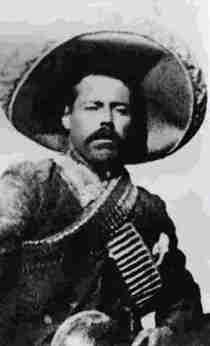| The World Between The Wars |
Pancho Villa

Pancho Villa was born on June, 5, 1878 in San Juan Del Rio, Durango.He was a Mexican revolutionary leader who supported the poor and fought for land reform. During his childhood, he observed and experienced the cruelty of peasant life. During the late 19th century, the rich were becoming richer and started to take advantage of the lower classes by making them slaves. Pancho Villa’s father died when he was only 15, which led to his job being a sharecropper in order to support his family. Pancho Villa found out that the plantation owner wanted to rape his sister so he shot him and then ran away to the mountains. During 1894 to 1910, he was running away from the consequences of killing the land owner. Pancho started to struggle to live on the run so he joined some bandits and eventually became their leader. The bandits did a lot of bad things like, steal cattle, and rob shipments of money from the wealthy. They would give the money stolen from the wealthy to the poor people. A few men that started a revolution realized that Pancho Villa has a great ability to escape being captured so they wanted him to join the revolution. They wanted to use Villa’s skills as a guerrilla fighter for the revolution. Pancho Villa was a very successful revolutionary leader, but, he resigned from command because he didn’t agree Pascual Orozco, Jr. On May 29, 1911, Pancho got married to Maria Luz Corral and wanted to relax and enjoy his life. Unfortunately, Madero’s presidency created more chaos, which led to Orozco starting a rebellion against Madero. Pancho’s relaxing life came to an end because he gathered troops and teamed up with Victoriano Huerta in support of Madero. Huerta and Villa’s alliance came to an end when Huerta accused Villa of stealing a horse and ordered him to be executed. Instead Pancho was sentenced to prison and escaped a couple months later. Huerta was then against Madero and killed him so he could be the president. Villa then created an alliance with Venustiano Carranza to fight against Huerta. He won multiple battles during the next couple of years, which resulted in gaining of land such as Chihuahua and other northern areas. Carranza and Villa’s alliance came to an end and they became enemies. This led to a civil war between the sides of Villa and Carranza. The United States intervened and fought for Carranza’s side. Villa was angered by this and attacked Columbus, New Mexico on March 9, 1916. Then, the United States sent soldiers to capture Pancho, but they never found him. Pancho Villa finally settled down in 1920; however he was shot in his car on July 20, 1923. Even though he was a killer, a bandit, and a revolutionary leader, many people saw him as a hero.
Citations:
"Pancho Villa." About.com 20th Century History. Web. 10 Mar. 2012.
<http://history1900s.about.com/cs/panchovilla/p/panchovilla.htm>.
"Pancho Villa." World History: The Modern Era. ABC-CLIO, 2012. Web. 11 Mar. 2012.
<http://worldhistory.abc-clio.com/Search/Display/316154?terms=mexican+revolution>.
Photo Citation:
"Being Latino Online Magazine." Being Latino Online Magazine. Web. 11 Mar. 2012.
<http://beinglatino.wordpress.com/2011/04/27/pancho-villa-and-akira-kurosawa-were-white-didn%E2%80%99t-you-know/>.
Citations:
"Pancho Villa." About.com 20th Century History. Web. 10 Mar. 2012.
<http://history1900s.about.com/cs/panchovilla/p/panchovilla.htm>.
"Pancho Villa." World History: The Modern Era. ABC-CLIO, 2012. Web. 11 Mar. 2012.
<http://worldhistory.abc-clio.com/Search/Display/316154?terms=mexican+revolution>.
Photo Citation:
"Being Latino Online Magazine." Being Latino Online Magazine. Web. 11 Mar. 2012.
<http://beinglatino.wordpress.com/2011/04/27/pancho-villa-and-akira-kurosawa-were-white-didn%E2%80%99t-you-know/>.
